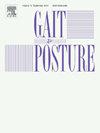成人脊柱畸形患者的弱干伸肌与矢状位错位和运动受限有关。
IF 2.2
3区 医学
Q3 NEUROSCIENCES
引用次数: 0
摘要
背景:成人脊柱畸形(ASD)与肌肉退行性变有关,影响姿势控制和最终矫正手术的结果。ASD的评估通常基于静态x线片和最近的功能评估。然而,对ASD中肌肉力量无力的探索有限。目的是研究ASD患者躯干肌肉强度与影像学和运动学改变以及生活质量下降之间的关系。方法:28例ASD和18例无症状患者行双平面x线片,三维计算脊柱-骨盆和整体体位参数。研究了从坐姿到站立和爬楼梯的步态的三维运动分析,并计算了头部、躯干和下肢的三维运动学。参与者填写了与健康相关的生活质量问卷。一名操作员使用手持测功机测量了4倍的躯干肌肉强度,以评估测量结果的可靠性。根据躯干伸肌的力量将ASD人群分为两组:ASD弱伸肌(N = )11例患者有躯干伸肌力量。结果:使用手持式肌力计测量肌肉力量是可靠的(ICC>0.94)。站立x线片显示,与其他组相比,asd弱伸肌组矢状位不正阳性增加(SVA=61 mm,而asd正常伸肌:18 mm,对照组:-4 mm, p )。结论:该研究表明,弱躯干伸肌与静态位置矢状位不正、日常生活活动中的运动学限制和生活质量评分降低有关。未来的研究将探讨肌肉强化对ASD患者静态和动态对齐及其生活质量的影响。本文章由计算机程序翻译,如有差异,请以英文原文为准。
Weak trunk extensors in adult spinal deformity patients are related to sagittal malalignment and kinematic limitations
Background
Adult spinal deformity (ASD) is associated with muscles’ degeneration that affects postural control and outcomes of an eventual corrective surgery. Evaluation of ASD is usually based on static radiographs and more recently on functional assessment. However, there has been limited exploration of muscle strength weakness in ASD. The aim was to investigate the relationship between trunk muscles’ strength in ASD and its relationship with radiographic and kinematic alterations and quality-of-life decline.
Methods
28 ASD and 18 asymptomatic subjects underwent biplanar radiographs with 3D calculation of spino-pelvic and global postural parameters. 3D movement analysis of gait, sitting to standing and stair ascent, was studied allowing the calculation of head, trunk and lower limbs 3D kinematics. Participants filled out health related quality of life questionnaires. A single operator measured 4 times the strength of the trunk muscles, using a hand-held dynamometer, to assess measurements’ reliability. ASD population was divided into two groups based on the strength of trunk extensors: ASD-weak extensors (N = 11 patients having trunk extensors strength<mean-1SD in controls) and ASD-normal extensors (N = 17). Radiographic, kinematic, and quality of life scores were compared between groups.
Results
Measurements of muscle strengths using the hand-held dynamometer were reliable (ICC>0.94). On standing radiographs, the ASD-weak extensors group showed an increased positive sagittal malalignment compared to the other groups (SVA=61 mm vs ASD-normal extensors: 18 mm, controls: −4 mm, p < 0.001). This sagittal malalignment remained during movement (kinematic-SVA=223 mm vs ASD-normal extensors:178 mm, controls:138 mm, p < 0.001). Muscle strength weakness was correlated to the decline of quality-of-life scores (PCS-SF36: r = 0.48, VAS for pain: ρ=-0.39).
Conclusions
This study showed that weak trunk extensors are associated with sagittal malalignment in static position, kinematic limitations during daily life activities and reduced quality of life scores. Future studies will investigate the effect of muscle strengthening on both static and dynamic alignment in ASD and their quality of life.
求助全文
通过发布文献求助,成功后即可免费获取论文全文。
去求助
来源期刊

Gait & posture
医学-神经科学
CiteScore
4.70
自引率
12.50%
发文量
616
审稿时长
6 months
期刊介绍:
Gait & Posture is a vehicle for the publication of up-to-date basic and clinical research on all aspects of locomotion and balance.
The topics covered include: Techniques for the measurement of gait and posture, and the standardization of results presentation; Studies of normal and pathological gait; Treatment of gait and postural abnormalities; Biomechanical and theoretical approaches to gait and posture; Mathematical models of joint and muscle mechanics; Neurological and musculoskeletal function in gait and posture; The evolution of upright posture and bipedal locomotion; Adaptations of carrying loads, walking on uneven surfaces, climbing stairs etc; spinal biomechanics only if they are directly related to gait and/or posture and are of general interest to our readers; The effect of aging and development on gait and posture; Psychological and cultural aspects of gait; Patient education.
 求助内容:
求助内容: 应助结果提醒方式:
应助结果提醒方式:


